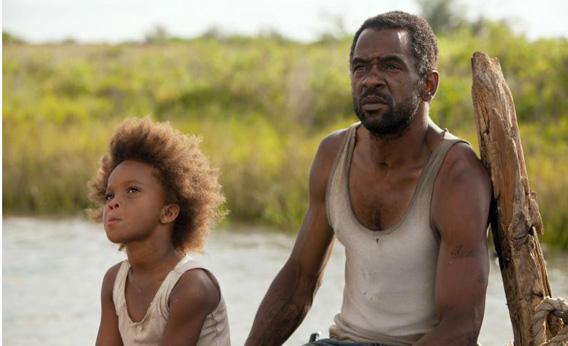|
Beasts of
the
Southern Wild records
the tempestuous life of a cavalier
6 year old named Hushpuppy (Quvenzhané Wallis).
Her childhood home is located in “The Bathtub”, a
Louisiana bayou separated from the developed world by a levee. This
marginalised
microcosm is home to a close-knit community of free spirits. There
Hushpuppy lives
with her ailing, alcoholic father, Wink (Dwight Henry), without her
mother. Wink
explains to Hushpuppy that her mother swam away. He further stokes the
formation
of his wife’s imaginary within Hushpuppy’s mind by spinning stories
about her
magical beauty, how she and him would spend time being shy around each
other and
how she once saved his life by shooting an approaching alligator.
Hushpuppy’s reception
of the natural environment around her is
glossed with wonderment as she idles time away frolicking
with a miscellany
of animals. Wink prepares Hushpuppy
for the hardships that she will encounter after his death by
implementing a paternal
program of tough love and life lessons.
Her erratic childhood thus gradually comes to be shaped by her fearless
curiosity,
scarred innocence and whimsical imagination. Drawing
on knowledge gleaned from her teacher Miss Bathsheeba
(Gina Montana), she falls into drifting spells where she imagines
melting polar ice caps that thaw a long-frozen horde of prehistoric Aurochs into life. A swirling sequence of dramatic events begins when a
fierce storm decimates
The Bathtub and culminates in Wink being advised that he does not have
long to live
by a hospital doctor. Wink is rendered bedridden as his condition
deteriorates towards
death. The traumatising situation leads
Hushpuppy to embark on a surreal search for her long-lost mother.

New
York filmmaker
Benh Zeitlin, 29, has attracted serious hype ever since his debut
feature premiered at the 2012 Sundance
Film Festival. Beasts
of the Southern Wild went on to collect, among others, a Grand Jury
Prize
at the Sundance, a Caméra
d’Or at the
Cannes and a Grand Jury Prize at
the Deauville American Film Festival. The
general perception amongst most critics is that his film is beautiful
and
miraculous - a perception
retrospectively textured by Zeitlin’s admissions that
Terrence Malick, John Cassavetes and Emir Kusturica are his key
influences. Indeed,
in the film, his debts to all three are highly visible but the final
vision is undeniably
Zeitlin’s own. The real rub is that
Zeitlin’s direction lacks artistic maturity. Based on
a one-act play composed by co-writer Lucy Alibar, Zeitlin’s
film is marred considerably by its raw unrestraint. Zeitlin uses
hand-held
cinematography to recreate reality just as Hushpuppy perceives it.
However, the
film winds up being too nauseatingly delirious and overwrought. It
ultimately comes
across as representing a sophomoric version of an established form of
art cinema
that has been previously executed with far more intelligence and skill
by far
superior directors before him. The film’s single redeeming quality
derives from
its acting, in particular Quvenzhané Wallis’
performance.
Only five when she was first cast, and seven by the time of
the film’s
completion, Wallis’ Hushpuppy is an extraordinary tour de
force. Yet all the inspired acting in the world could not quell
the displeasure that this film elicits.
Zeitlin still has a long way to go in proving that his baffling
overachievement was
no undeserved fluke.
|